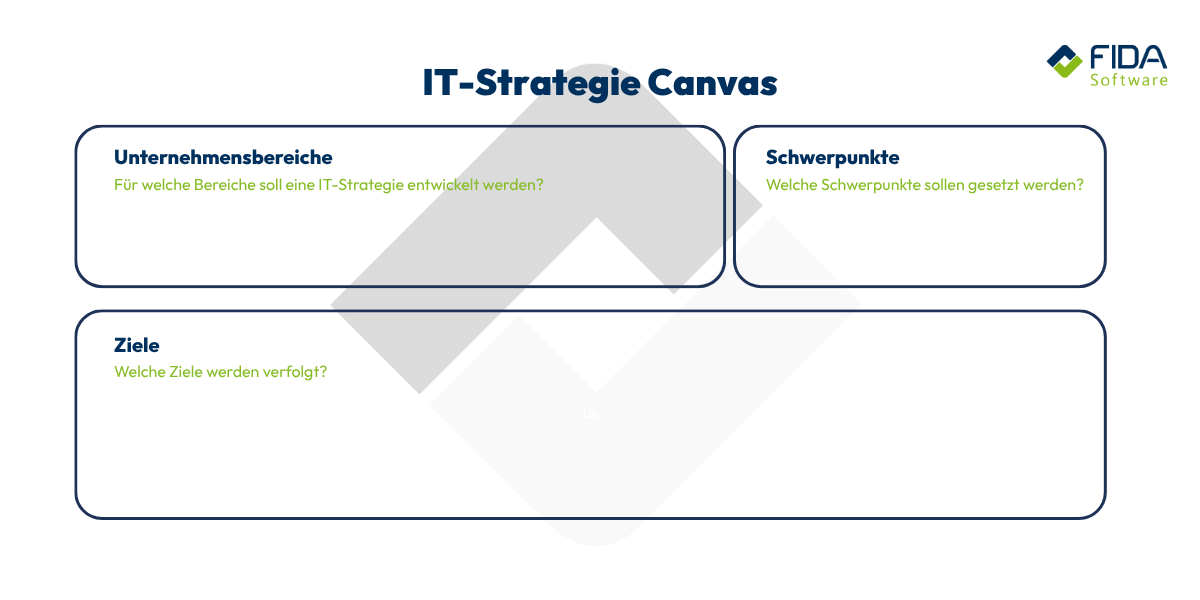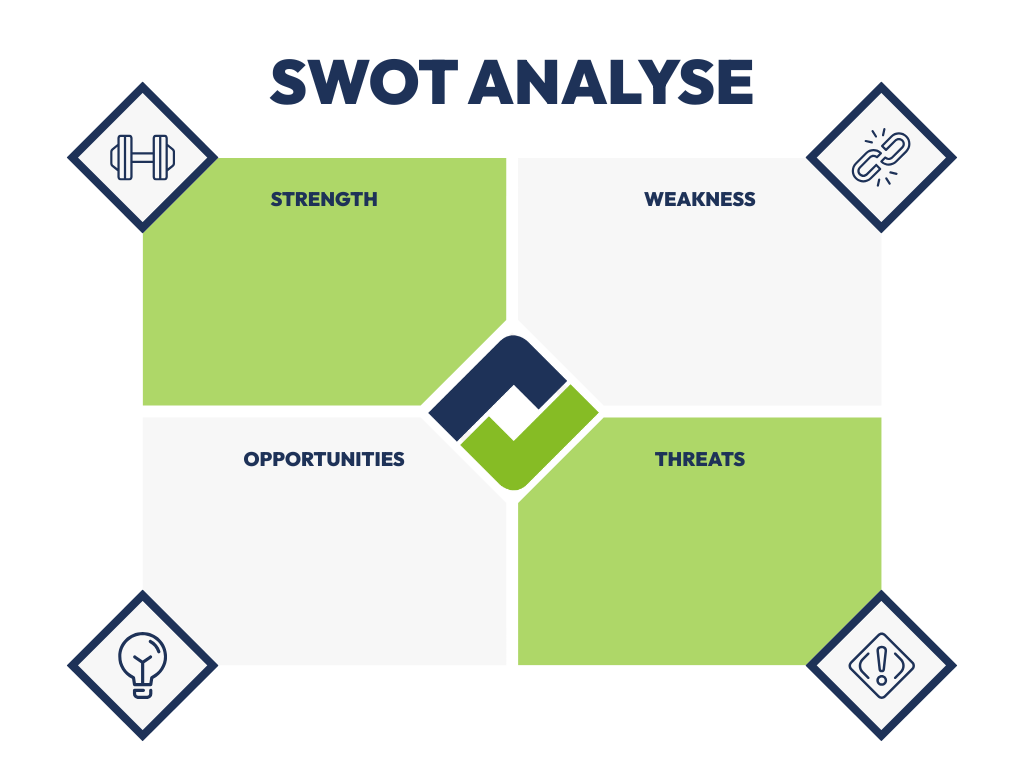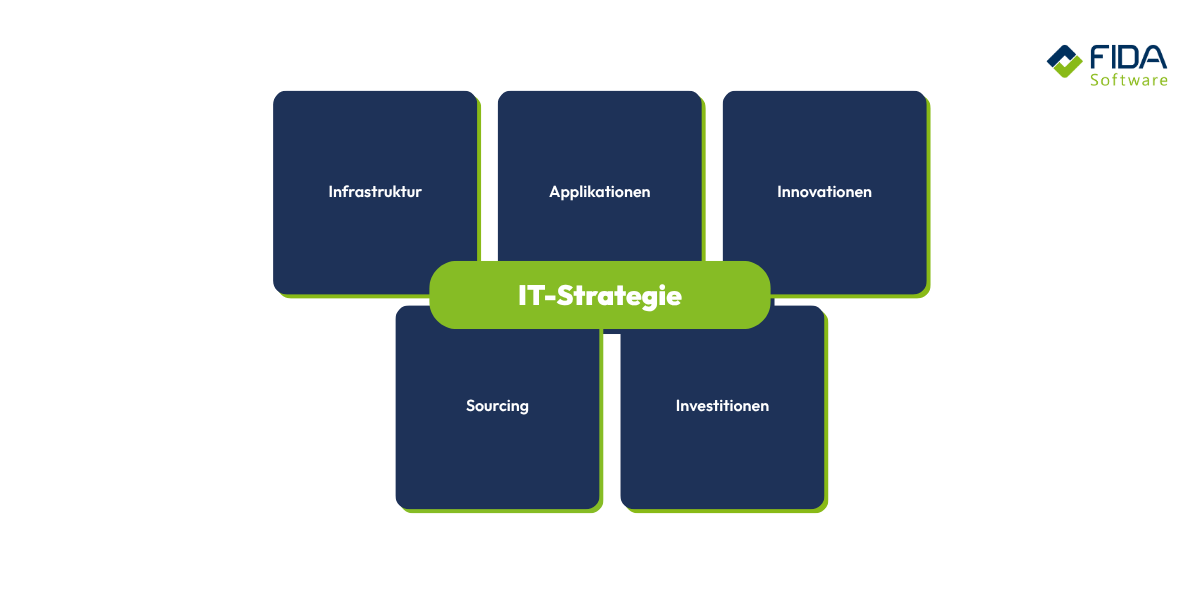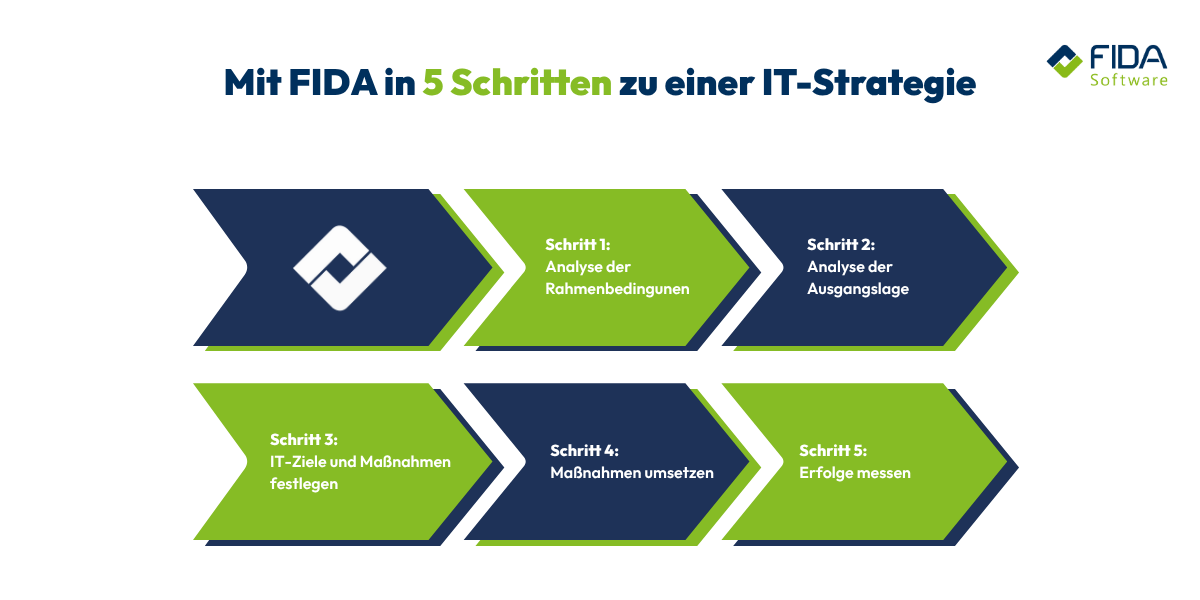
Developing an IT strategy: 5 steps to a stable IT infrastructure.
Today, IT is far more than just technical infrastructure - it is the backbone of every modern company. But while technologies are developing rapidly, many organizations remain stuck in old structures.
Systems grow unplanned, processes become more complex and ultimately there is a lack of clear direction. Developing an IT strategy is therefore a key task for IT managers and executives in order to ensure the company's competitiveness.
A well thought-out IT strategy provides orientation. It ensures that your IT not only functions reliably, but also actively contributes to business success. The aim is to create structures that are flexible, secure and future-proof - and that fit your company's goals precisely, with information technology playing a decisive role as a strategic success factor and the view of the IT strategy as an integral part of the company organization. Sound analyses are essential in order to set the right course for a successful IT strategy.
With our experience from numerous IT projects, we at FIDA know what is important: a successful IT strategy begins with an understanding of your business - and ends with solutions that really work.
Strategies and actively shaping the transformation within the organization are crucial to achieving sustainable change. In this article, we show you how to develop an IT strategy that works in five steps.

What is an IT strategy - and why do you need one?
An IT strategy defines the long-term course of your information technology. It provides the framework within which your IT management operates, sets priorities for decisions and provides orientation for future developments and innovations.
In short: the IT strategy links your corporate goals with the practical day-to-day IT work. It ensures that technology is not an end in itself, but supports your business processes in a targeted manner - today, tomorrow and in the future. It is important that the IT strategy is closely aligned with the company's business objectives in order to ensure efficiency and competitive advantages.
Especially in times of rapid digitalization and the increased use of AI solutions, this is crucial. After all, the success of a company has long depended on how well its IT is used. Whether to automate processes, open up new business areas or improve the customer experience.
A good IT strategy helps you do this,
Make processes more efficient,
make sensible use of the opportunities offered by new technologies,
make work easier for your team,
make data-based decisions
and inspire your customers in the long term.
For this to succeed, the IT strategy must always be anchored at the highest level. A clear direction can only be created if management and IT pull together. Close cooperation between various managers such as the CIO, CTO and management is particularly crucial in order to develop a coordinated and holistic IT strategy.
To summarize: You can think of the IT strategy like a map. It shows you where you are, where you want to go and which paths lead there. It makes obstacles visible - and helps you to stay on course even in confusing terrain. Existing information and data from reports, documents or analyses form an important basis for developing and reviewing the IT strategy.
How to determine which IT services your strategy should really cover
Before you start with the actual strategy work, you should determine the exact scope of your IT strategy. This means you determine which topics, areas and goals it should cover.
The first step is to clarify three points:
Company areas: Does the strategy apply to the entire company or only to certain locations, business areas or units?
IT priorities: Which topics are the main focus - for example, business-critical systems such as ERP and CRM, innovation projects or the further development of the system landscape?
Goal and depth of the strategy work: Are you developing a completely new strategy, revising an existing one or adding new topics to it?
A clearly defined scope prevents new topics from being added over the course of the project ("scope creep") - which often leads to delays or a standstill, especially if fields of action are not identified and prioritized at an early stage. A well thought-out IT strategy covers all relevant topics and content that are important for the respective areas of action.
SWOT analysis - clarity about strengths, weaknesses, opportunities and risks
Before you define your IT strategy, it is worth taking a closer look at the status quo - and this is where the SWOT analysis can help. The SWOT analysis evaluates internal strengths and weaknesses as well as external opportunities and threats.
Using this method, you can identify where your IT is currently excelling - for example with stable systems, dedicated teams or modern infrastructure - and where there is a need for action. At the same time, it helps you to realistically assess external developments such as new technologies, market changes or legal requirements.
The five central building blocks of an IT strategy
Every IT strategy is based on five sub-strategies that are aligned with the business strategy and influence each other. Together, they form the foundation for a sustainable and future-oriented IT strategy.
1. infrastructure strategy
It defines how you design networks, hardware and operating systems so that they are powerful, secure and cost-efficient. The aim is to create a stable basis for all IT services - with sufficient computing power, bandwidth and flexibility for the future.
2. application strategy
This is about your applications and systems - in other words, which software solutions you use, how they interact and how they support your business processes. A good application strategy shows which tools deliver real added value, such as CRM systems for customer loyalty, ERP solutions for efficient processes or software for accounting and HR management.
3. innovation strategy
The innovation strategy looks ahead: it evaluates new technologies, trends and basic technologies such as artificial intelligence, cloud or automation. The aim is to recognize at an early stage which developments can advance your company - and how they can be put to good use.
4. sourcing strategy
This is where you decide which IT services you will provide yourself and which you will purchase - such as cloud services, software-as-a-service or traditional on-premises solutions. Effective IT supply management plays a central role here, as it supports the strategic planning and organization of IT procurement and thus helps to simplify the IT landscape and optimize costs and efficiency. The focus is on achieving the optimum balance between costs, performance, security and flexibility.
5. investment strategy
The investment strategy ensures the efficient and targeted use of your IT budget. It defines the criteria and cycles according to which investments are made and how the return on investment (ROI) can be measured. This ensures that every investment supports your overall strategy by making resources and funds available in a targeted manner in order to successfully implement the investment strategy.
Develop a successful IT strategy in 5 steps.
An IT strategy is not created overnight. It is the result of a continuous, dynamic process in which you constantly take a fresh look at your company, your goals and your IT. A structured approach is crucial to developing and implementing a successful IT strategy.
The following five phases will help you to proceed in a structured and targeted manner:
Step 1: Understanding the context - What influences your IT strategy?
The first question to ask is: What environment are you operating in?
Analyze which framework conditions determine the scope of action of your IT - such as customer requirements, legal requirements or stakeholders, but also budget limits, security guidelines or internal processes.
The more clearly you know this environment, the better you can align your IT strategy to it.
Step 2: Analyze the initial situation - where do you stand today?
Get an honest picture of your current IT situation. Which systems are in use and how well do they support your business goals?
Also look at external factors: What technological trends are relevant? What are competitors doing better - or worse?
Evaluate your strengths, weaknesses, opportunities and risks. This inventory forms the basis for every strategic decision.
Step 3: Determine IT goals - where do you want to go?
Now it's time to get specific: define your vision for the future.
What role should your IT play in the company in the future? What are your priorities - such as automation, data security, customer experience or cost optimization?
Determine which measures will have a real impact and how they contribute to your corporate strategy. A good IT strategy remains realistic - it balances vision, benefits and feasibility.
Step 4: Implement strategy - how do you reach your goal?
A strategy is only as good as its implementation. Formulate concrete measures, milestones and responsibilities.
Plan sufficient resources and ensure that everyone involved - from the management to the specialist departments - supports the course.
The clearer the communication, the smoother the implementation.
Step 5: Measure success - have you achieved your goal?
Implementation is followed by monitoring: what has your IT strategy achieved?
Regularly check whether your goals have been achieved and make adjustments if necessary. Tools such as an IT scorecard help you to visualize progress and reprioritize.
After all, an IT strategy is not a one-off project, but an ongoing process of further development.

What are the benefits of a sound IT strategy?
A good IT strategy not only brings structure to your IT. It creates real added value for the entire company. As soon as clear goals and responsibilities are defined, your IT becomes more transparent, easier to manage and measurably more successful. Decisions are made on the basis of facts rather than gut instinct.
A well-thought-out IT strategy directly advances your IT management and your company. You can see some of these benefits immediately:
Direct benefits of a professional IT strategy
Better IT management: Clear goals and responsibilities make IT more transparent, easier to manage and easier to communicate internally.
Cost efficiency: Resources are deployed in a targeted manner, processes are designed more efficiently and investments are planned sustainably.
Risk minimization: Compliance and risk management are strengthened and potential problems are identified at an early stage.
Investment security: Decisions on IT investments are based on sound foundations, cost-benefit aspects are evaluated more clearly.
Promotion of innovation: New technologies and trends can be evaluated, researched and implemented in a targeted manner.
Stable performance: Infrastructure and systems are always available with sufficient capacity, IT operations run reliably.
In addition, an IT strategy has far-reaching effects that strengthen the entire company:
Indirect benefits of an IT strategy
Better customer satisfaction: Stable systems and optimized processes improve services and the customer experience.
Greater employee satisfaction: Efficient systems make work easier and increase motivation and productivity.
Cost reduction through automation: Recurring tasks can be automated through targeted IT support.
Competitive advantages: Early use of innovative technologies secures a lead over competitors.
Development of new business areas: New IT solutions and innovative processes enable new products and services.
Greater transparency: Company processes become easier to understand, decisions more well-founded.
Strategy process as added value: workshops, interviews and documentation promote mutual understanding and strengthen cooperation throughout the company.

Change management - successfully shaping change
An IT strategy is only effective if the changes are actually implemented in the company. This is where change management comes into play. It ensures that new processes, systems and working methods are understood, accepted and actively supported by everyone involved.
It is important that you communicate at an early stage why the changes are necessary, what benefits they will bring and how they will be implemented. Workshops, training courses and continuous exchange help to reduce uncertainty and get the team on board.
Conclusion: IT strategy as the key to corporate success
Today, a clear IT strategy is no longer an optional extra, but a decisive success factor. It ensures that technology and business objectives go hand in hand, processes run more efficiently, innovations are used in a targeted manner and risks are controlled. Companies that strategically align their IT secure competitive advantages, increase customer and employee satisfaction and create a solid basis for future growth.
At FIDA, we support you right from the start - from the analysis and definition of sub-strategies through to implementation and success monitoring. This ensures that your IT strategy doesn't just exist on paper, but really works and helps your company to make sustainable progress.
FAQ: Frequently asked questions about IT strategy
An IT strategy is the long-term plan for how you use your information technology to achieve your business goals. It defines priorities, structures and processes and ensures that your IT not only works, but also creates real added value.
Your IT strategy describes the individual way in which your IT supports the corporate strategy. It defines which systems, applications and technologies are used, what role IT plays in the company and how it contributes to achieving business goals.
A complete IT strategy usually consists of five sub-strategies:
Infrastructure strategy - defines the technical basis (hardware, networks, operating systems).
Application strategy - controls the use of software and applications.
Innovation strategy - evaluates new technologies and trends.
Sourcing strategy - regulates what is developed internally or sourced externally.
Investment strategy - ensures efficient use of budget and resources.
The ICT strategy (Information and Communication Technology) expands the view of the IT strategy to include communication systems. It therefore also includes topics such as telephony, collaboration tools and digital communication channels - in short, everything that enables the exchange of information and data within the company.
An IT strategy comprises the goals, measures, priorities and responsibilities for the use of IT in the company. This includes an analysis of the current situation, a clear definition of objectives, a roadmap for implementation and mechanisms for monitoring and adaptation.
The path to an IT strategy involves several steps:
Stake out the framework (define scope)
Carry out an as-is analysis (SWOT analysis, system check, needs assessment)
Set goals and priorities
Develop strategy and roadmap
Plan implementation and monitoring
It is important that you understand the process as a continuous development - a good IT strategy lives and grows with your company.





